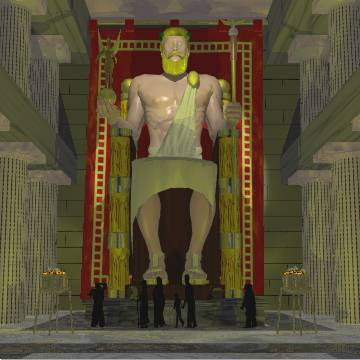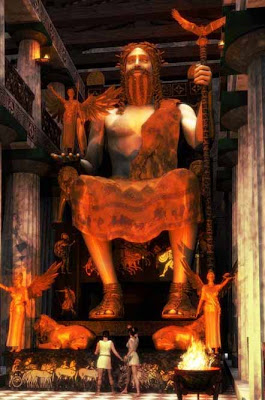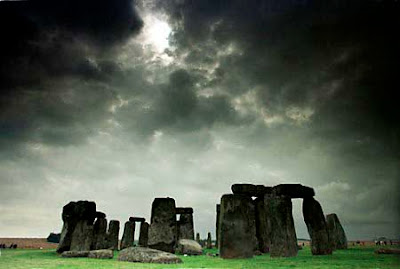Animals Zoo Park |
- Iguacu Falls Information Pictures
- The Statue of Zeus Info Photos at Olympia
- Stonehenge Info Pictures of Stonehenge
| Iguacu Falls Information Pictures Posted: 25 Jan 2010 10:39 AM PST Iguacu Falls location : The Iguaçú Falls are located in the Iguaçú National Park, at the border of Brazil and Argentina. Iguacu Falls Information : In a horseshoe form, 2,700 meters wide between the two countries, the Iguaçú Falls fill the visitors's view with the spray of 72 meter-high falls - the number of them varies between 150 and 300, depending on the flow of the Iguaçú River. The panorama overwhelms the onlooker with a sensation of fright, fascination and respect for the perfection of nature. A visit to the Falls and the contact with wildlife and the spectacle of the waters awake an emotion that many hope to experience once in a lifetime. Iguacu Falls Pictures -    |
| The Statue of Zeus Info Photos at Olympia Posted: 25 Jan 2010 10:35 AM PST The Wonders of the Ancient World Info Photos and Pictures : The Statue of Zeus at Olympia  The Statue of Zeus at Olympia Photo The Statue of Zeus at Olympia Photo The Statue of Zeus Olympia Photo The Statue of Zeus Olympia Photo The Statue of Zeus at Olympia The Statue of Zeus at Olympia The Statue of Zeus at Olympia Photo The Statue of Zeus at Olympia PhotoThis is the statue of the god in whose honor the Ancient Olympic games were held. It was located on the land that gave its very name to the Olympics. At the time of the games, wars stopped, and athletes came from Asia Minor, Syria, Egypt, and Sicily to celebrate the Olympics and to worship their king of gods: Zeus.  The Statue of Zeus at Olympia The Statue of Zeus at OlympiaIn the ancient world, there were many temples dedicated to Zeus, the king of the Greek gods. But, there was only one temple to Zeus that housed one of the seven wonders of the ancient world. The Temple of Zeus at Olympia was home to one of greatest sculptural achievements of ancient history. The Statue of Zeus at Olympia represented the pinnacle of Classical sculptural design, as well as showcased the engineering that was required to construct such a massive chunk of marble and gold. The city-state of Olympia was a center of religious worship, and was also the birthplace of the Olympic games. Believed to have begun in 776 B.C., the Olympic games demonstrated the physical prowess as well as the political strength of the participating Greek poleis. The Olympic games were considered to be a part of religious rituals that revolved around the king of the Greek gods, Zeus. So it was only fitting that a grand temple and an even grander cult representation were constructed for the many Greeks who made pilgrimages there in order to worship their father god. The temple of Zeus was built between 466 - 456 B.C., during the height of Classical Greek architecture and artistic endeavors. It was designed by Libon, an architect from neighboring Elis. The temple was constructed of local shell stone in the Doric style, the predominant architectural style of the time, and the same style as the Parthenon in Athens. The temple itself acted merely as a protective home for the real showpiece, the cult statue of Zeus himself. The renowned Greek sculptor Pheidias brought Zeus to life with his creation around 435 B.C. After creating the cult statue of Athena for the Parthenon, Pheidias left Athens in shame as a result of a political scandal and an erroneous embezzlement charge. He immediately came to Olympia to begin work on Zeus. Pheidias had developed a technique that allowed his enormous creations of ivory and precious metals to be formed without crumbling under their own weight. Beginning with a wooden frame built on site, he would lay thin plates of ivory soaked in a liquid to make them moldable, and place them upon the mold along with sheets of gold (for Zeus draping clothing). The pieces matched up perfectly, and the joints were nearly invisible. The appearance of the statue must have been imposing, impressive, and awe-inspiring. The seated statue was over 40 feet tall. Zeus' throne was just as impressive, constructed of cedar and inlaid with ivory, gold, and ebony. He held a statue of Nike, the Greek goddess of victory, in his left hand, and a staff with an eagle perched atop it in his right hand. The statue inspired reverence for over 800 years in its temple home in Olympia. Kings and even Roman Emperors who gazed upon it were known to cry in veneration. In fact, the Roman Emperor Caligula even tried to have the statue taken for himself in the late 30's A.D., with no success. In the 450's A.D., it was taken from the temple to Constantinople, where it sat in a palace. The palace was destroyed by fire in 462 A.D., and one of the seven wonders of the ancient world was unfortunately lost forever. |
| Posted: 25 Jan 2010 10:29 AM PST |
| Stonehenge Info Pictures of Stonehenge Posted: 25 Jan 2010 01:07 AM PST The Seven Wonders of the Medieval Mind : Stonehenge Info - Stonehenge Pictures and Wallpapers  Stonehenge Stonehenge Stonehenge Wonders Picture Stonehenge Wonders Picture Stonehenge at Sun set Pics Stonehenge at Sun set Pics Stonehenge Pictures Stonehenge Pictures Stonehenge Picture Stonehenge PictureStonehenge Info : Stonehenge is surely Britain's greatest national icon, symbolizing mystery, power and endurance. its original purpose is unclear to us, but some have speculated that it was a temple made for the worship of ancient earth deities. It has been called an astronomical observatory for marking significant events on the prehistoric calendar. Others claim that it was a sacred site for the burial of high-ranking citizens from the societies of long ago. While we can't say with any degree of certainty what it was for, we can say that it wasn't constructed for any casual purpose. Only something very important to the ancients would have been worth the effort and investment that it took to construct Stonehenge. The stones we see today represent Stonehenge in ruin. Many of the original stones have fallen or been removed by previous generations for home construction or road repair. There has been serious damage to some of the smaller bluestones resulting from close visitor contact (prohibited since 1978) and the prehistoric carvings on the larger sarsen stones show signs of significant wear. Construction of the Henge In its day, the construction of Stonehenge was an impressive engineering feat, requiring commitment, time and vast amounts of manual labor. In its first phase, Stonehenge was a large earthwork; a bank and ditch arrangement called a henge, constructed approximately 5,000 years ago. It is believed that the ditch was dug with tools made from the antlers of red deer and, possibly, wood. The underlying chalk was loosened with picks and shoveled with the shoulderblades of cattle. It was then loaded into baskets and carried away. Modern experiments have shown that these tools were more than equal to the great task of earth digging and moving. The Bluestones About 2,000 BC, the first stone circle (which is now the inner circle), comprised of small bluestones, was set up, but abandoned before completion. The stones used in that first circle are believed to be from the Prescelly Mountains, located roughly 240 miles away, at the southwestern tip of Wales. The bluestones weigh up to 4 tons each and about 80 stones were used, in all. Given the distance they had to travel, this presented quite a transportation problem. Modern theories speculate that the stones were dragged by roller and sledge from the inland mountains to the headwaters of Milford Haven. There they were loaded onto rafts, barges or boats and sailed along the south coast of Wales, then up the Rivers Avon and Frome to a point near present-day Frome in Somerset. From this point, so the theory goes, the stones were hauled overland, again, to a place near Warminster in Wiltshire, approximately 6 miles away. From there, it's back into the pool for a slow float down the River Wylye to Salisbury, then up the Salisbury Avon to West Amesbury, leaving only a short 2 mile drag from West Amesbury to the Stonehenge site. Construction of the Outer Ring The giant sarsen stones (which form the outer circle), weigh as much as 50 tons each. To transport them from the Marlborough Downs, roughly 20 miles to the north, is a problem of even greater magnitude than that of moving the bluestones. Most of the way, the going is relatively easy, but at the steepest part of the route, at Redhorn Hill, modern work studies estimate that at least 600 men would have been needed just to get each stone past this obstacle. Once on site, a sarsen stone was prepared to accommodate stone lintels along its top surface. It was then dragged until the end was over the opening of the hole. Great levers were inserted under the stone and it was raised until gravity made it slide into the hole. At this point, the stone stood on about a 30° angle from the ground. Ropes were attached to the top and teams of men pulled from the other side to raise it into the full upright position. It was secured by filling the hole at its base with small, round packing stones. At this point, the lintels were lowered into place and secured vertically by mortice and tenon joints and horizontally by tongue and groove joints. Stonehenge was probably finally completed around 1500 BC. Who Built Stonehenge? The question of who built Stonehenge is largely unanswered, even today. The monument's construction has been attributed to many ancient peoples throughout the years, but the most captivating and enduring attribution has been to the Druids. This erroneous connection was first made around 3 centuries ago by the antiquary, John Aubrey. Julius Caesar and other Roman writers told of a Celtic priesthood who flourished around the time of their first conquest (55 BC). By this time, though, the stones had been standing for 2,000 years, and were, perhaps, already in a ruined condition. Besides, the Druids worshipped in forest temples and had no need for stone structures. The best guess seems to be that the Stonehenge site was begun by the people of the late Neolithic period (around 3000 BC) and carried forward by people from a new economy which was arising at this time. These "new" people, called Beaker Folk because of their use of pottery drinking vessels, began to use metal implements and to live in a more communal fashion than their ancestors. Some think that they may have been immigrants from the continent, but that contention is not supported by archaeological evidence. It is likely that they were indigenous people doing the same old things in new ways. As Legend Has It The legend of King Arthur provides another story of the construction of Stonehenge. It is told by the twelfth century writer, Geoffrey of Monmouth, in his History of the Kings of Britain that Merlin brought the stones to the Salisbury Plain from Ireland. Sometime in the fifth century, there had been a massacre of 300 British noblemen by the treacherous Saxon leader, Hengest. Geoffrey tells us that the high king, Aurelius Ambrosius, wanted to create a fitting memorial to the slain men. Merlin suggested an expedition to Ireland for the purpose of transplanting the Giant's Ring stone circle to Britain. According to Geoffrey of Monmouth, the stones of the Giant's Ring were originally brought from Africa to Ireland by giants (who else but giants could handle the job?). The stones were located on "Mount Killaraus" and were used as a site for performing rituals and for healing. Led by King Uther and Merlin, the expedition arrived at the spot in Ireland. The Britons, none of whom were giants, apparently, were unsuccessful in their attempts to move the great stones. At this point, Merlin realized that only his magic arts would turn the trick. So, they were dismantled and shipped back to Britain where they were set up (see illus. at right) as they had been before, in a great circle, around the mass grave of the murdered noblemen. The story goes on to tell that Aurelius, Uther and Arthur's successor, Constantine were also buried there in their time*. Present Day Stonehenge Situated in a vast plain, surrounded by hundreds of round barrows, or burial mounds, the Stonehenge site is truly impressive, and all the more so, the closer you approach. It is a place where much human effort was expended for a purpose we can only guess at. Some people see it as a place steeped in magic and mystery, some as a place where their imaginations of the past can be fired and others hold it to be a sacred place. But whatever viewpoint is brought to it and whatever its original purpose was, it should be treated as the ancients treated it, as a place of honor . The modern age has not been altogether kind to Stonehenge, despite the lip service it pays to the preservation of heritage sites. There is a major highway running no more than 100 yards away from the stones, and a commercial circus has sprung up around it, complete with parking lots, gift shops and ice cream stands. The organization, English Heritage, is committed to righting these wrongs, and in the coming years, we may get to see Stonehenge in the setting for which it was originally created. Despite all its dilapidation and the encroachment of the modern world, Stonehenge, today, is an awe-inspiring sight, and no travel itinerary around Britain should omit it.  Wonderful Lighting Picture Wonderful Lighting Picture Beautiful Gallery Wallpaper Beautiful Gallery Wallpaper Stonehenge Wallpaper Stonehenge Wallpaper Wonders Gallery Photo Wonders Gallery Photo |
| You are subscribed to email updates from Animals Zoo Park To stop receiving these emails, you may unsubscribe now. | Email delivery powered by Google |
| Google Inc., 20 West Kinzie, Chicago IL USA 60610 | |
No comments:
Post a Comment
Note: Only a member of this blog may post a comment.